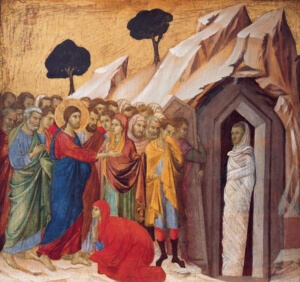By Monika Manser
Introduction
The most frequent way of praying that Saint Ignatius uses is that of imagining ourselves in a Gospel scene. We imagine ourselves as a character in the story. We take part in the story, seeing Jesus and all the other people, being aware of what’s going on and how we are feeling. The purpose of praying with the imagination is to allow Christ in the Scripture to speak to us. To bring the Gospel stories to life for us. We are not trying to recreate history. It doesn’t matter if your imagination takes the story off in a different direction to the Scripture. It doesn’t matter if the story takes place in 1st century Palestine or where we live now in the 21st century. What is important is what God wants to say to us through this passage.
Let us sit and relax so that together we can contemplate the Gospel using our imagination.
Prayer
We acknowledge we are in the presence of God so let us say together:
Direct O Lord and guide and influence all that is happening in my mind and heart during this time of prayer: all my moods and feelings, my memories and imaginings; my hopes and desires; may all be directed and influenced to your greater glory, praise and service and to my growth in your Spirit.
Amen
Let the Spirit enter our hearts and enlighten our minds to that fact that nothing is impossible to God if only we have the faith to believe.
Reading
John 11:1-45
There was a man named Lazarus who lived in the village of Bethany with the two sisters, Mary and Martha, and he was ill. It was the same Mary, the sister of the sick man Lazarus, who anointed the Lord with ointment and wiped his feet with her hair.
The sisters, Martha and Mary, sent this message to Jesus, “Lord, the man you love is ill.” On receiving the message, Jesus said, “This sickness will end not in death but in God’s glory, and through it the Son of God will be glorified.” Jesus loved Martha and her sister and Lazarus, yet when he heard that Lazarus was ill he stayed where he was for two more days before saying to the disciples, “Let us go to Judea.”
On arriving, Jesus found that Lazarus had been in the tomb for four days already. Bethany is only about two miles from Jerusalem, and many Jews had come to Martha and Mary to sympathise with them over their brother.
When Martha heard that Jesus had come she went to meet him. Mary remained sitting in the house. Martha said to Jesus, “If you had been here, my brother would not have died, but I know that, even now, whatever you ask of God, he will grant you.” “Your brother,” said Jesus to her “will rise again.” Martha said, “I know he will rise again at the resurrection on the last day.” Jesus said: “I am the resurrection. If anyone believes in me, even though he dies he will live, and whoever lives and believes in me will never die. Do you believe this?” “Yes, Lord,” she said, “I believe that you are the Christ, the Son of God, the one who was to come into this world.”
Jesus said in great distress, with a sigh that came straight from the heart, “Where have you put him?” They said, “Lord, come and see.” Jesus wept; and the Jews said, “See how much he loved him!” But there were some who remarked, “He opened the eyes of the blind man, could he not have prevented this man’s death?”
Still sighing, Jesus reached the tomb: it was a cave with a stone to close the opening. Jesus said, “Take the stone away.” Martha said to him, “Lord, by now he will smell; this is the fourth day.” Jesus replied, “Have I not told you that if you believe you will see the glory of God?” So they took away the stone.
Then Jesus lifted up his eyes and said: “Father, I thank you for hearing my prayer. I know indeed that you always hear me, but I speak for the sake of all these who stand round me, so that they may believe it was you who sent me.”
When he had said this, he cried in a loud voice, “Lazarus, here! Come out!” The dead man came out, his feet and hands bound with bands of stuff and a cloth round his face. Jesus said to them, “Unbind him, let him go free.”
Many of the Jews who had come to visit Mary and had seen what he did believed in him.
Contemplation
Today’s Gospel on the 5th Sunday of Lent, like the past two Sundays, breaks from the Year of St Matthew and tells of the Rising of Lazarus found in John’s Gospel. This scene at Bethany is a sad one, not only for Martha and Mary who have just lost their brother but for Jesus who has lost a friend. Imagine the scene, find a place within it. With the help of the Spirit, let the story unfold in your imagination.
- Who are you within the story? Are you Martha, Mary, Lazarus, one of his disciples, a grieving friend or an unnoticed bystander? Perhaps a person or thing that is not specially mentioned in the printed story?
-
What time of day is it? What is the atmosphere like? Hot? Oppressive? Crowded? Is there an atmosphere of grief, confusion or even anger? What can you see, hear and feel around you?
-
What is the location like? What are the sounds, the smells, and the other details about the location that you notice?
-
Were you with Jesus when he received the message from the sisters? If so, how did Jesus react? How did you and the others around you react? Did you think that Jesus should have gone to Martha and Mary immediately he received the message or did you think he had a reason for delaying?
-
Perhaps you were the one who sent the message to Jesus or you were with the sisters when they sent the message. If you sent the message, why did you send it? If you were with the sisters, what was their mood like? How did they feel? Were they desperate because they knew how ill Lazarus was? Did they think that Jesus could cure him?
-
Do you arrive at Bethany with Jesus? If so what do you notice? Who is there? How are people reacting towards the situation? How do they interact? Perhaps they are sad, comforting each other?
- Or are you at Bethany when Jesus arrives? What is your reaction when you see him? Do you want to interact with Jesus? If so, what do you want to say to him? Are you angry with him for coming when it was too late? How do you feel about the accusatory remarks by Martha when she saw Jesus? Did you agree with her? How do you feel about her profound faith? Do you truly believe that anything is possible if only you believe? Do you doubt that Jesus can bring life? How do you encounter Jesus in such moments?
-
Do you notice Jesus reacting differently to the two sister?. To Martha’s questions, Jesus questions her faith? To Mary’s anguish, Jesus shares her distress? Do you hear his sigh coming straight from his heart? Do you notice that Jesus places no barriers to his feelings about the death of his friend? Do you ever try to hide your feelings?
-
What do you hear, see or feel when you see Jesus calling Lazarus from the tomb? Are you afraid when you see Lazarus being brought back from the dead? What are the reactions of those around you?
Speak to Jesus about the times you have been entombed in hopelessness, bound by worry and about the areas in your life that feel dead. Ask him for the grace to hear his voice call, “Unbind him. Let him go”
We will sit with our thoughts and imagination for 10 minutes
Sharing
Let us now share what we thought, felt etc. only if you are comfortable to do so.
End Prayer
Suscipe of St. Ignatius of Loyola
Take, Lord, and receive all my liberty,
my memory, my understanding,
and my entire will,
All I have and call my own.
You have given all to me.
To you, Lord, I return it.
Everything is yours; do with it what you will.
Give me only your love and your grace,
that is enough for me.
Scripture texts: from the Jerusalem Bible 1966 by Dartington Longman & Todd Ltd and Doubleday and Company Ltd




